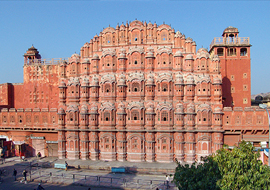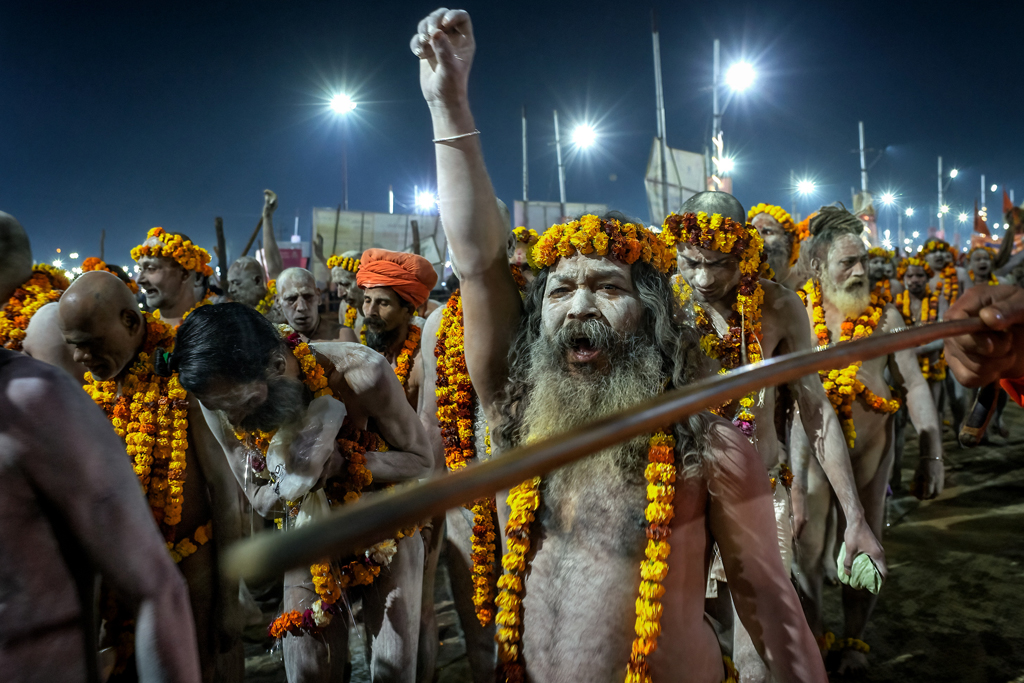Brief Intro about Kumbh Mela
Maha Kumbh Mela is one of the most important religious festivals and considered to host largest human spiritual gathering, is the most incredible site. Kumbh Mela is a lifetime experience for anyone who is interest in Indian culture or philosophy because Sadhus and Sanyasis (Hindu religious ascetic or Monk) come to participate in this holy event from remote forests and mountains which is their hideaway for as the isolation and harsh environment away from mainstream society is ideal for performing meditation and their spiritual practices.
Maha Kumbh at Prayagraj (formerly known as Allahabad) takes place after a long duration of 12 years which makes it all the more exciting to be a part of this great occasion as the next such big event will come after a long gap of more than a decade. The Kumbh Mela dates are decided on astrological position the moon, the sun and Jupiter. As Jupiter takes about 11 years, 10 months and 14 days to complete its revolution around the sun, it’s obvious that it comes back to any specific position on its orbit on completion of nearly 12 years. Although Kumbh Mela takes places at four places; Prayagraj (Allahabad), Haridwar, Nashik and Ujjain, but Kumbh Mela held in Prayagraj is most significant and attracts more visitors from all over the world than other places as this is the confluence of three holy rivers in India; Ganga, Yamuna and mythical Saraswati become one.
What is the difference between Ardh Kumbh and Maha Kumbh?
- The Maha Kumbh or just called Purna (full) Kumbh occurs after every 12 years.
- The Ardh (half) Kumbh takes place every 6 years at Prayagraj (Allahabad) and Haridwar.
- Kumbh festival in 2019 in Prayagraj was Ardh Kumbh where as Kumbh Mela to be held in 2025 is Pruna (full) Kumbh.
- Maha Kumbh is considered to be most important and auspicious than Ardh (half) Kumbh.
Suggested Tours

Golden Traingle Tour of India
6 Nights - 7 Days

Nepal Tour
8 Nights - 9 Days

Orissa Tribal Tour
11 Nights - 12 Days

Central India Tour
12 Nights - 13 Days
History and Origin of Kumbh Mela
There is uncertainty about the exact origin of Kumbh Mela and when it started. There is no historical evidence about this fact but there are many references to these kind of religious and spiritual festivals on riverside. Few scholars claim that Kumbh Mela started in 3464 BC. You find mention of this event in various historical manuscripts dating back to thousand years. A Greek Ambassador is said to have visited India during 4th century BC during Kumbh Mela. Famous Chinese traveller Hiuen Tsang has also mentioned about a festival organized at the confluence of two rivers during his visit in 7th century. Adi Shankara, a Hindu philosopher and saint popularized the Kumbha Mela among common people in 8th century.
According to Hindu mythology, the origin of the Kumbh dates back to the time when amrita kalasha (pot of nectar of immortality) was recovered from Samudramanthan (during the churning of the primordial sea), after which a brutal war between devatas (Gods) and asuras (Demons) ensued. To prevent the amrita kalasha being taken into posesion by asuras, who were more powerful than the devatas, its safety was entrusted to the devatas Brahaspati (Jupiter), Surya (Sun), Chandra (Moon), and Shani (Saturn).
The four devatas ran away with the amrita kalasha to hide it from the asuras. Learning the conspiracy of the devatas, the asuras turned ferocious and chased the 4 devatas running with amrita kalasha. The chase lasted 12 years, during which the devatas and asuras went round the earth. During this chase, the devatas hid amrita kalasha at the cities Haridwar, Prayag, Ujjain and Nasik. According to other legends, the fight took place between devatas and asuras, resulting in the amrita kalasha being knocked, out of which amrita (Nectar) fell down at the 4 places. To commemorate this holy event of the amrita kalasha being put at 4 places, Kumbh is celebrated every 12 years in Haridwar, Allahabad (Prayagraj), Ujjain and Nashik.
Where is next Maha Kumbh in 2025?
The next Kumbh Mela or Maha Kumbh is going to take place in Prayagraj which was formerly known as Allahabad.
Prayagraj (Allahabad) is an important city of great religious and historical significance. It was formerly known as Prayag ‘Place of sacrifice’. It is believed to be the spot where Lord Brahma offered his first sacrifice after creating the world. There is not much known about the ancient history of Prayagraj and it was controlled Mughals in 16th century. The city was named Allahabad or ‘City of Gods’ by the Mughal Emperor Akbar. In 1765, the British established a garrison at the fort of Allahabad. The city played a significant role during India’s struggle for independence. Recently it’s name has been changed to Prayagraj.
When is next Kumbh Mela
Kumbh Mela is Prayagraj will take place from 13th January 2025 till 26th February 2025. The Maha Kumbh will start on important occasion of Paush Purnima and end after Shahi Snan on Shiv Ratri.
Important Bathing Dates : Allahabad Kumbh Mela 2025
- 13 JANUARY, 2025 : PAUSH PURNIMA
- 14 JANUARY 2025: MAKAR SANKRANTI (SHAHI SNAN)
- 29 JANUARY 2025: MAUNI AMAVASYA SNAN (SHAHI SNAN)
- 03 FEBRUARY 2025: BASANT PANCHAMI (SHAHI SNAN)
- 12 FEBRUARY 2025: MAGHI PURNIMA SNAN
- 26 FEBRUARY 2025: MAHA SHIVRATRI
Attractions of Kumbh Mela
ACTIVITIES DURING KUMBH MELA
TAKE A DIP MAKE A WISH
If you go by the Hindu mythologies, then this is the only time and place in the world where you can unburden your sins and achieve ‘Nirvana’ from the vicious cycle of birth and re birth. Take dips in the holy water of Ganges that is said to wash away all the sins of a person. Light a Diya and make a wish, they do come true!
SOJOURN ON THE ASHRAMS ON THE BANKS
To live among the Sadhus, who have dedicated their entire lives in meditation and fulfilling spiritual deeds is indeed a unique experience of life. During Kumbh Mela, there are many Ashrams which are set up for this special occasion where the Sadhus along with disciples stay and have discourses about religion and Hindu philosophy. You may also join them and take advantage of their preaching.
SATSANG
Satsang is a Sanskrit word which means “to be in the company of true people”, which practically means sitting with a sat guru, or in a group of learned people for seeking the knowledge and learn the philosophy of life for one’s betterment.
Satsangs are integral part of the Kumbh Mela. Devotees listen to the Sadhus patiently for hours who preach how to lead a good life and to attain moksha. There are many ashrams where people can offer their prayer. You are free to sit inside if you wish to learn what the priests have to say about Hinduism and spiritualism as these saints have a good knowledge of religion. You may also get an opportunity to even interact with them and take pictures of them with their permission. Although they may not talk much, but, if you have patience and are respectful, you may initiate a dialogue and discuss Hindu philosophy and religion with them.
SURRENDER TO PEACEFUL ACTIVITIES
Taking dips three times in a day, attending yoga classes, listening to the divine lectures and participating in the cultural programmes are just a few of the activities that one can enjoy during the famous Kumbh Mela in Allahabad
THE SADHUS AT THE KUMBH MELA
The sadhus and other holy men are an integral part of the Kumbh Mela. Pilgrims who attend the Kumbh Mela come to see and listen to these men, in order to gain spiritual enlightenment.
TYPES OF SADHUS:
NAGAS: Naked sadhus who smear their bodies with ash and have long matted hair. Constant exposure to the weather makes them resistant to temperature extremes. Their eyes are bloodshot from constantly smoking charas (Marijuana), which they believe aids enlightenment.
URDHWAVAHURS: who have emaciated bodies from rigid spiritual practice.
PARIVAJAKAS: Who have taken a vow of silence.
SHIRSHASINS: who remain standing, sleep with their heads resting on a vertical pole, and meditate standing on their Heads.
KALPVASIS: Who remain by the river banks and devote their time to meditating, performing rituals, and bathing numerous times a day.
How to reach Prayagraj (Allahabad)
BY AIR
Prayagraj is served by the Prayagraj (Allahabad) Airport (Bamrauli Air Force Base) and is linked to Delhi by direct flight from various Indian cities.
- MUMBAI
- DELHI
- PUNE
- BHOPAL
- BENGALURU
- BHUBANESHWAR
- LUCKNOW
- DEHRADUN
BY RAIL
Prayagraj is the major hub and headquarters of the North Central Railway. It is therefore well connected to major cities in India by trains.
BY ROAD
Prayagraj is connected by Highway NH2 which runs through the middle of the city. Besides There are other National and state highways that link Prayagraj to all other parts of the country.
Distances
| FROM | TO | DISTANCE |
|
Prayagraj (Allahabad)
|
VARANASI
|
120 KM
|
|
Prayagraj (Allahabad)
|
KOLKOTTA
|
750 KM
|
|
Prayagraj (Allahabad)
|
DELHI
|
670 KM
|
|
Prayagraj (Allahabad)
|
KHAJURAHO
|
280 KM
|
|
Prayagraj (Allahabad)
|
LUCKNOW
|
200 KM
|
|
Prayagraj (Allahabad)
|
AGRA
|
470 KM
|
WHAT KIND OF ACCOMMODATION IS AVAILABLE DURING KUMBH MELA?
It is not advisable to stay in a hotel in Prayagraj for few reasons. One is that these hotels are quite at a distance from Kumbh mela site and it would be very difficult to commute from the city to Kumbh epic centre where all the activities would take place. A sprawling tent city will be set up between Sangam, Arail and Phahamau in Prayagraj.
Here, you would find a range of accommodation, from basic tents to most luxurious camp. It is not difficult to find good accommodation in a decent camp with attached toilet with hot & cold water and various other amenities to make your stay comfortable. There is a dining camp where you can have breakfast, lunch, evening tea and dinner.





